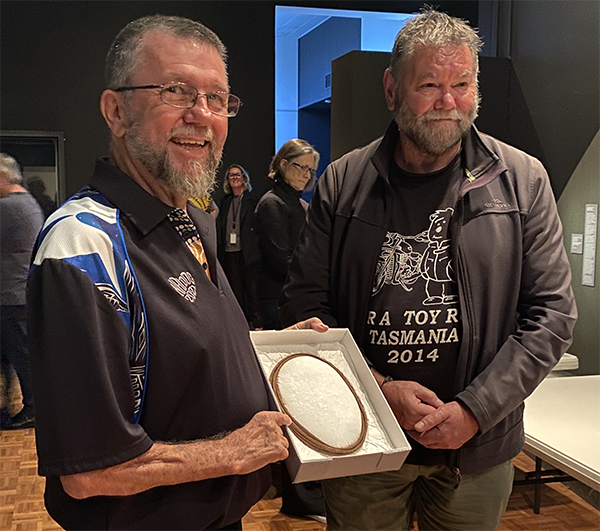Pakana man Andrew Gall created his own red-ochred necklace as an interpretation of the returned artefact. (Image: supplied, Tasmanian Museum and Art Gallery).
Callan Morse, “We think it is the only one in existence” – red ochre necklace returns to Tasmania after two centuries, National Indigenous Times, 25 April 2023
A unique red ochre necklace has been returned to Tasmania for the first time in nearly two centuries.
The Tasmanian Aboriginal ancestral object, the last of 12 made by Tasmanian Aboriginal ancestors, has been returned for the first time in at least 190 years as part of the Tasmanian Museum and Art Gallery’s taypani milaythina-tu: Return to Country exhibition.
taypani milaythina-tu: Return to Country is an ambitious long-term project to reconnect Tasmanian Aboriginal people with culturally significant objects that are held in institutions nationally and globally.
The exhibition also features the contributions of 20 Tasmanian Aboriginal artists, who have created responses to retuned cultural objects that are co-exhibited in the exhibition alongside returned objects.
Andrew Gall, one of the exhibitions contributing artists crafted his own red-ochred necklace from kangaroo skins in response to the original necklace.
“(The original) necklace is one of the most significant Tasmanian Aboriginal items held in any museum around the world – we think it is the only one in existence,” Mr Gall said.
Mr Gall said the return of historically significant artefacts and objects to Tasmania provides an opportunity for Tasmanian Aboriginal people to reconnect to culture.

“It is incredibly important for Palawa people to be able to see it on their Country once again,” Mr Gall said.
“Once it is here, we will be able to reawaken the knowledge of how it was made and what it is made of. Without it here, that is impossible.
“It is so important for those of us living now and for future generations that we are able to reawaken the 60,000 years of knowledge that was lost so quickly when colonisation happened.”
The necklace has been repatriated from Chicago’s Field Museum by the Regenstein Pacific Curatorial Team staff members.
Tasmanian Museum and Art Gallery (TMAG) director Mary Mulchay said the museum was delighted in the return of the necklace to be exhibited alongside Mr Gall’s work.
She said the Field Museum purchased the necklace as part of a collection of British artefacts, however, the details of how the necklace ended up in England are unclear.
“The necklace was collected and sent to England some time before 1834 – but we do not know exactly when or how it reached England,” Ms Mulchay said.

“The Field Museum in Chicago purchased a collection of artefacts from a British collector in 1958 that included 93 items from Tasmania. Today the Field Museum cares for almost 200 items from Tasmania – including the red ochred necklace.”
Ms Mulchay said the necklace resembles that worn by Wurati, a Tasmanian Aboriginal man from Bruny Island who accompanied colonial George Robinson on Tasmanian exhibitions and also spend time with Robinson in Victoria’s Port Phillip district.
“It is the only necklace of this type known in existence and looks like the necklace worn by Wurati in the portrait by Thomas Bock and the bust of Wurati by Benjamin Law, both of which are also on display in the taypani milaythina-tu exhibition,” Ms Mulchay said.
Chris Philipp and Julia Kennedy from the Field Museum travelled to Tasmania to deliver the necklace.
“We are honoured to participate in this item’s return to home for inclusion in the taypani milaythina-tu exhibition and are very much looking forward to the ensuing dialogues that result from reconnecting this necklace to the Tasmanian community and with the Field Museum,” Mr Philipp said.
The necklace is on loan for two years and is currently on display at the Tasmanian Museum and Art Gallery.

